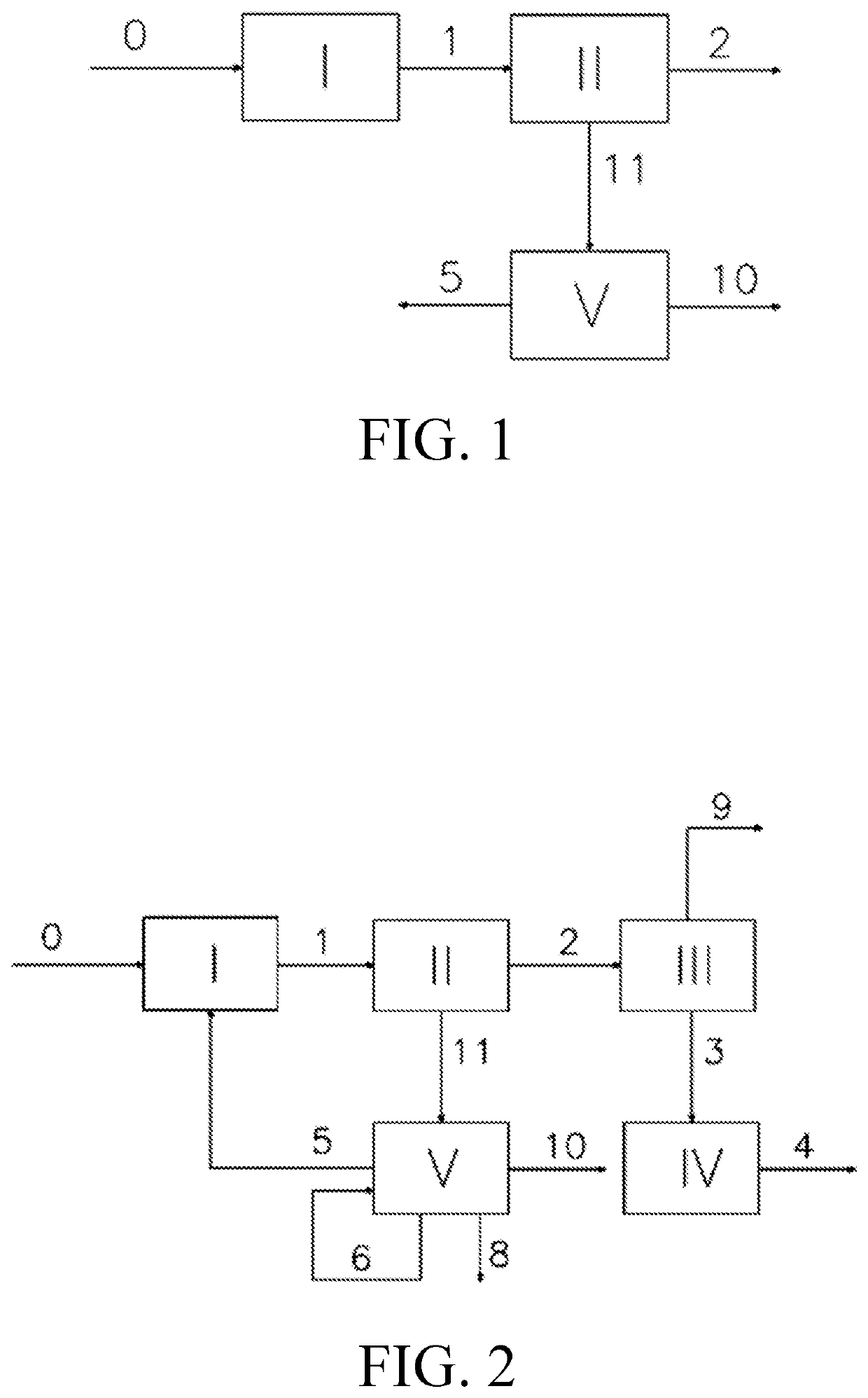Process for producing ethylene
a technology of ethylene and ethylene, which is applied in the direction of hydrocarbon by metathesis reaction, hydrocarbon preparation catalyst, chemical production, etc., can solve the problems of low yield of ethylene, and relatively difficult separation of ethylene from ethane, so as to reduce the overall energy consumption of the production process, reduce the energy required by the separation device, and improve the overall yield of ethylene.
- Summary
- Abstract
- Description
- Claims
- Application Information
AI Technical Summary
Benefits of technology
Problems solved by technology
Method used
Image
Examples
example 1
[0178]The flow chart shown in FIG. 1 was adopted:
[0179]Stream 0 contained 50% C4 olefin, 20% C5 olefin, 15% C6 olefin, 5% C7 olefin, 5% C8 olefin, and 5% C4 alkane, with a total flow rate of 1000 kg / h. Stream 0 was fed into unit I for reaction, wherein the unit I utilized the OCC technology from Shanghai Petrochemical Research Institute, and the catalyst was an OCC-II type catalyst, with a reaction temperature of 590° C., a reaction pressure of 0.01 MPa, and a reaction space velocity of 20 h−1. Stream 0 was subjected to catalytic cracking reaction in the unit I to obtain stream 1 containing ethylene and propylene. Stream 1 was fed into unit II, wherein the unit II utilized a common rectification method, with a column pressure of 2.4 MPa, a column top temperature of −24° C., a theoretical tray number of 50, so as to obtain a C3 stream 11 with a C2 content of less than 0.09% at the column bottom, and stream 2 with an ethylene content of 70% at the column top. Stream 11 was fed into un...
example 2
[0182]The flow chart shown in FIG. 2 was adopted:
[0183]Stream 0 contained 50% C4 olefin, 20% C5 olefin, 15% C6 olefin, 5% C7 olefin, 5% C8 olefin, and 5% C4 alkane, with a total flow rate of 1000 kg / h. Stream 0 was fed into unit I for reaction, wherein the unit I utilized the OCC technology from Shanghai Petrochemical Research Institute, and the catalyst was an OCC-II type catalyst, with a reaction temperature of 590° C., a reaction pressure of 0.011 MPa, and a reaction space velocity of 20 h−1. Stream 0 was subjected to catalytic cracking reaction in the unit I to obtain stream 1 containing ethylene and propylene. Stream 1 was fed into unit II, wherein the unit II utilized a common rectification method, with a column pressure of 2.4 MPa, a column top temperature of −24° C., and a theoretical tray number of 50, so as to obtain stream 2 with an ethylene content of 70% at the column top, and a C3 stream 11 with a C2 content of less than 0.09% at the column bottom. Stream 2 was fed int...
example 3
[0186]The flow chart shown in FIG. 2 was adopted:
[0187]Stream 0 contained 50% C4 olefin, 20% C5 olefin, 15% C6 olefin, 5% C7 olefin, 5% C8 olefin, and 5% C4 alkane, with a total flow rate of 1000 kg / h. Stream 0 was fed into unit I for reaction, wherein the unit I utilized the OCC technology from Shanghai Petrochemical Research Institute, and the catalyst was an OCC-II type catalyst, with a reaction temperature of 590° C., a reaction pressure of 0.011 MPa, and a reaction space velocity of 20 h−1. Stream 0 was subjected to catalytic cracking reaction in the unit I to obtain stream 1 containing ethylene and propylene. Stream 1 was fed into unit II, wherein the unit II utilized a common rectification method, with a column pressure of 2.4 MPa, a column top temperature of −24° C., and a theoretical tray number of 50, so as to obtain stream 2 with an ethylene content of 70% at the column top, and a C3 stream 11 with a C2 content of less than 0.09% at the column bottom. Stream 2 was fed int...
PUM
| Property | Measurement | Unit |
|---|---|---|
| reaction temperature | aaaaa | aaaaa |
| pressure | aaaaa | aaaaa |
| pressure | aaaaa | aaaaa |
Abstract
Description
Claims
Application Information
 Login to View More
Login to View More - R&D
- Intellectual Property
- Life Sciences
- Materials
- Tech Scout
- Unparalleled Data Quality
- Higher Quality Content
- 60% Fewer Hallucinations
Browse by: Latest US Patents, China's latest patents, Technical Efficacy Thesaurus, Application Domain, Technology Topic, Popular Technical Reports.
© 2025 PatSnap. All rights reserved.Legal|Privacy policy|Modern Slavery Act Transparency Statement|Sitemap|About US| Contact US: help@patsnap.com


